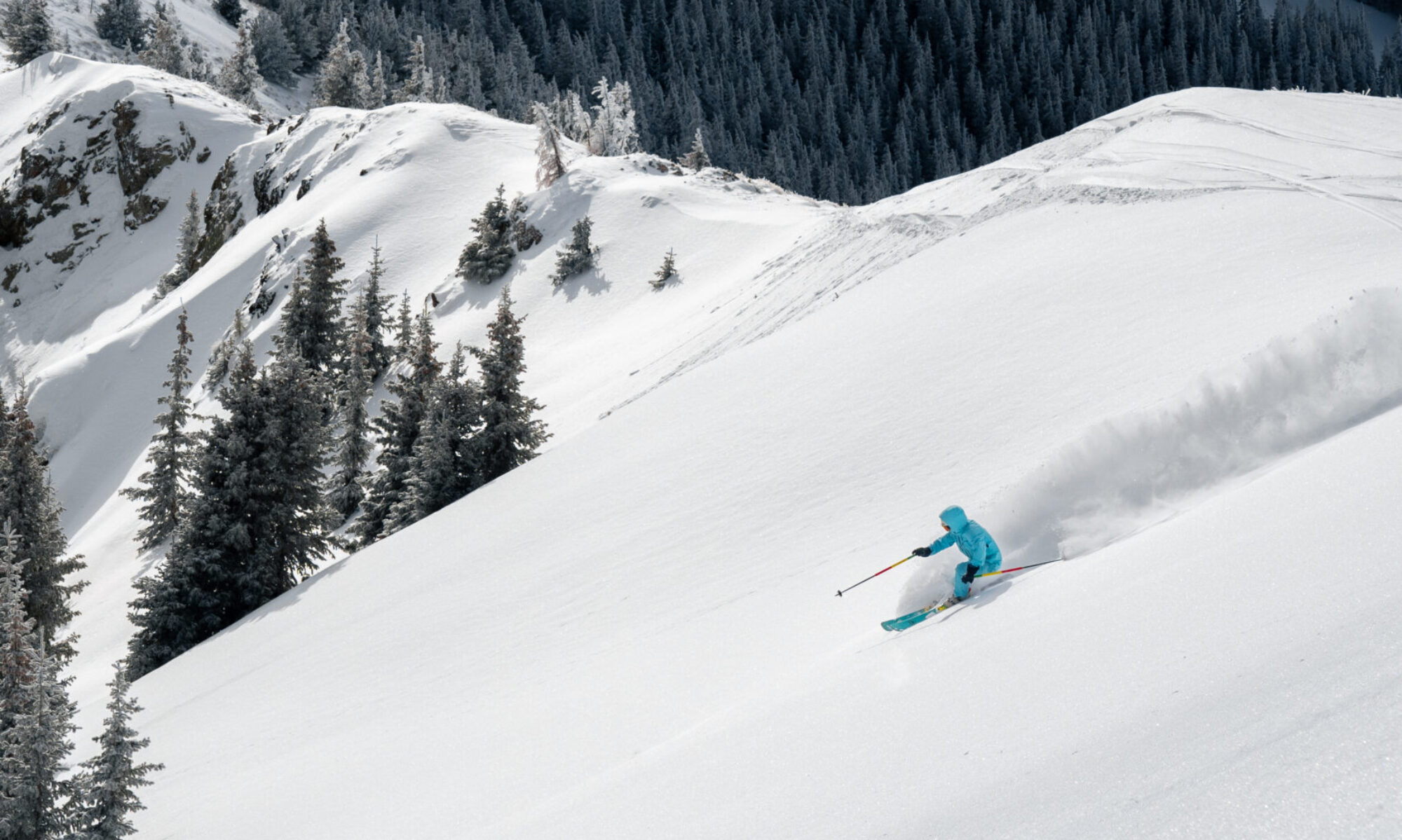Preparedness san save your life in the high country
By Cindy Brown
Winter in Taos sparkles with powdery snow and brilliant blue-sky days. The mesas and mountains invite you outdoors to backcountry ski, snowshoe, or hike. But clear mornings can quickly shift to stormy, bone-chilling afternoons.

The Taos Search and Rescue team in the early parts of the hike to search the “missing” mushroom hunter during February 2025 training.
Last winter, several high-profile rescues near Taos Ski Valley underscored the risks. In one dramatic case, two young hikers stranded near Wheeler Peak had to be hoisted out by a National Guard Black Hawk helicopter in the middle of the night — a dangerous operation for everyone involved.

Taos Search and Rescue’s Delinda VanneBrightyn and Berger Blanc Suisse K9 AkioYodasan during the early phase of the hike to find Chad Belvill, an associate broker who went “missing” in his search for mushrooms.
Lessons from the Mountain
“Anything can happen in the blink of an eye,” explains Delinda VanneBrightyn, president of Taos Search and Rescue (TSAR) and leader of the group’s canine unit. “You could twist your ankle and it changes everything. It doesn’t require a severe injury to be dangerous.”
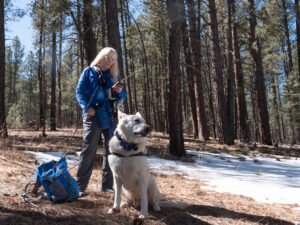
Taos Search and Rescue’s Delinda VanneBrightyn and Berger Blanc Suisse K9 AkioYodasan during the early phase of the hike to find Chad Belvill, an associate broker who went “missing” in his search for mushrooms.
Visitors, especially those coming from lower elevations, often underestimate how severe winter conditions can be above 9,000 feet. “It’s stunning to me that people don’t realize the seriousness of climbing mountains in the winter,” VanneBrightyn says. “Reading rescue stories is one way to learn what can go wrong.”
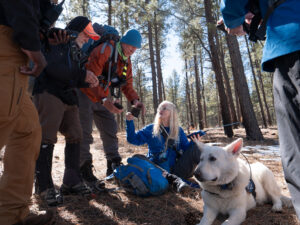
The Taos Search and Rescue team comes together as they prepare to triangulate the “missing” mushroom hunter.
She recalls two hikers in their 20s who began their trek late in the day. By the time they turned to descend, the sun had set, temperatures had plummeted, and the snow had iced over. Without proper winter gear — no crampons, ice picks, or insulating layers — they were unable to move. When rescuers finally reached them after 10 p.m., both were hypothermic, one nearly unconscious. A helicopter hoist was the only option.
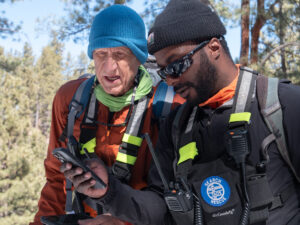
Wes Foote and Ikhide Ikhigbonoaremen set up their GPS tracker to search for the “missing” mushroom hunter.
“One way this could have been prevented is preparation,” VanneBrightyn emphasizes. “Multiple clothing layers, a waterproof outer shell, a bivy sack or sleeping bag, warming packs — all of these could make the difference.”

Taos Search and Rescue’s Berger Blanc Suisse AkioYodasan sniffs an empty energy drink can found by the team that was considered a “clue.” A clue can be anything belonging to or left by the subject. Each clue’s reliability is rated. In this case, the can was old and more likely left by another hiker.
More rescues, more warnings
That helicopter mission wasn’t the only emergency last season. “We had at least three rescues early last winter of people who were injured, lost, or in over their heads,” says Matt Rogers, chief of the Taos Ski Valley Fire Department. “A lot of people are not prepared for the hazards of a high alpine environment.”

Footprints on the snow can be considered a clue. A clue can be anything belonging to or left by the subject such as personal belonging. Each clue’s reliability is rated.
In one case, a hiker slid down an icy slope and became trapped on the edge of a shelf before a rope team reached him. In another, a camper between Fraser Mountain and Wheeler Peak found himself unable to light a fire or stove in heavy snowdrifts. Fortunately, he carried a personal locator beacon that allowed rescuers to pinpoint his location.

After finding the “injured” Chad Belvill, the mushroom hunter, the team applied first aid on his compound fracture, made sure he’s comfortable and packaged him for the medical airlift.
Rogers stresses the importance of timing. “Bring more equipment than you think you’ll need, and don’t wait until 5 p.m. to call for help,” he says. “Everything is harder after dark — especially a helicopter rescue. The situation has to be life and death before we’ll risk it.”
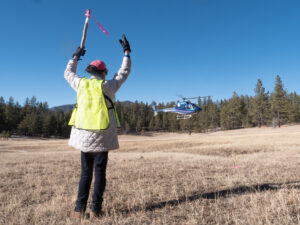
Taos Search and Rescue volunteer Jenny George helps the medivac helicopter land safely in mostly flat plains just off NM 518.
The message from rescuers is clear: don’t underestimate the mountains. A little extra preparation can make the difference between a grand adventure and a life-threatening ordeal.
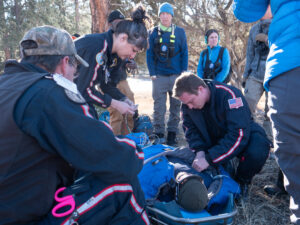
Flight paramedics, from left, Chuck Schultz, Sarah Rivali and Adrian Zabka tend to the “missing” mushroom hunter, Chad Belvill, and get him ready for the medical helicopter.
Preventing Disaster
- Know your limits: Alpine winter travel is far more demanding than summer hiking.
- Plan ahead: Check weather and avalanche forecasts, and return before sunset.
- Gear up: Beyond the “Ten Essentials,” bring traction devices, poles, extra batteries, and fire-starting tools. For longer trips, add an ice pick, locator beacon, hand warmers, and a bivy sack or sleeping bag.
- Layer wisely: Start with moisture-wicking base layers, add warmth with fleece, and top with a wind- and waterproof shell. Waterproof boots are a must.
- Watch for hypothermia: Shivering, slurred speech, and confusion are red flags.
- Don’t go solo: Always let someone know your plan, and consider hiring a guide or exploring with an established ski area.
— Members of TSAR, the TSV fire department, and the Carson National Forest contributed these tips.
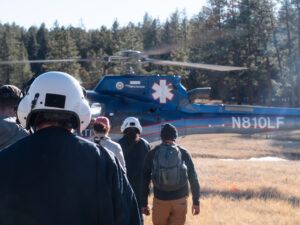
Flight paramedics and the Taos Search and Rescue volunteers approach the medical helicopter for a hot load/unload practice.
Resources
- U.S. Forest Service: Winter safety guidance at fs.usda.gov
- Taos Avalanche Center: Daily avalanche reports at taosavalanchecenter.org
- American Hiking Society: “Ten Essentials” and winter tips at americanhiking.org
